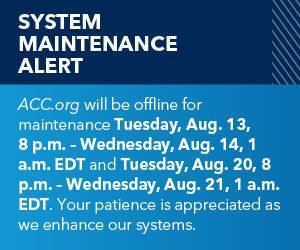Leadless Ultrasound-Based CRT System in HF
Quick Takes
- In patients with HF unable to receive conventional CRT, use of a leadless ultrasound-based LV endocardial pacing system for CRT was feasible and had an acceptable safety profile.
- Use of this novel CRT strategy was associated with reductions in LV end-systolic volume from baseline to 6 months.
Study Questions:
In patients with heart failure (HF) unable to receive conventional cardiac resynchronization therapy (CRT), is a leadless left ventricular (LV) endocardial pacing system (WiSE CRT System) for CRT safe and effective?
Methods:
The SOLVE-CRT study was a prospective, multicenter trial from January 2018 to September 2022 using the WiSE CRT System (leadless LV endocardial pacing stimulated by a subcutaneous ultrasound transmitter and triggered by right ventricular pacing). The initial trial was designed as a randomized, double-blind study comparing use of the WiSE CRT System for CRT therapy (device implanted and turned on) to control (device implanted but turned off). Due to enrollment limitations related to the COVID-19 pandemic, the study was revised to be a single-arm, nonrandomized study of the WiSE CRT System. The combined study included patients meeting indications for CRT but either were high risk for device upgrade (HRU group) or were deemed previously untreatable (PU group) because of failed coronary sinus lead placement or coronary sinus lead-related issues resulting in the lead being turned off. The initial randomized study also included a group designated as nonresponders to conventional CRT, but these patients were not recruited for the single-arm study and not included in the efficacy analysis. All patients were included in the safety analysis.
The primary safety endpoint was freedom from adverse events caused by any component of the investigational system (transmitter, battery, electrode, delivery catheter, programming software) or procedure-related events (electrode complication, vascular event, stroke, pericardial effusion, pocket-related event) at 6 months. The primary efficacy endpoint was mean percentage change in LV end-systolic volume (LVESV) from baseline to 6 months.
Results:
The initial randomized part of this study enrolled 108 patients. Of these, 99 underwent WiSE CRT System implant (47 in treatment arm, 52 in control arm). Of the 47 patients in the treatment arm, 25 were enrolled in the study under the HRU or PU indications and included in the efficacy analysis. An additional 75 patients were enrolled in the single-arm part of the study, and all underwent WiSE CRT implant. The study was stopped early after meeting primary safety and efficacy goals. A total of 183 patients were included in the safety analysis and 100 were included in the efficacy analysis.
For the overall cohort, the mean age was 68.1 (standard deviation 10.3) years and 141 (77%) were male. For the primary safety endpoint, the freedom from predefined safety events at 6 months was 80.9% (lower bound of the one-sided 98.8% confidence interval [CI], 73.4%) and was significantly higher than the prespecified performance goal of 70% (p < 0.001). This included 12 investigational system-related (6.6%), 12 pocket-related (6.6%), seven cardiac perforation (3.8%), five vascular (2.7%), and three stroke (1.6%) events. For the primary efficacy endpoint, the mean percentage change in LVESV at 6 months was -16.4% (95% CI, -21.0% to -11.7%) and was significantly lower than the prespecified performance goal of -9.3% (p = 0.003).
Conclusions:
In patients with HF unable to receive conventional CRT, use of a leadless ultrasound-based LV endocardial pacing system has acceptable safety outcomes and is associated with reductions in LVESV.
Perspective:
While the benefits of CRT for a subset of patients with HF have long been recognized, a significant number of patients may be considered nonresponders, have contraindications to device upgrade, or have had an unsuccessful device upgrade. Options for these patients are limited and alternative strategies are needed. The results of this study suggest one possible and promising solution with the WiSE CRT System. Use of this system was associated with a generally acceptable safety profile (though the complication rate still approached 20%) and associated with reductions in LVESV. While these data are encouraging, it is unfortunate that the randomized trial design needed to be revised due to low enrollment during the COVID-19 pandemic. This means it is still unclear how the system would have performed against a sham comparator arm and how much recent improvements in pharmacologic therapy for HF may have contributed. The small study design and nonrandomized nature of the study also precluded assessment of impact on clinical outcomes like mortality. Future studies are needed to clarify some of these lingering questions and further analysis of the nonresponder group of patients from this study may provide additional insights.
Clinical Topics: Arrhythmias and Clinical EP, Heart Failure and Cardiomyopathies, Implantable Devices, Acute Heart Failure
Keywords: Cardiac Resynchronization Therapy, Heart Failure
< Back to Listings

